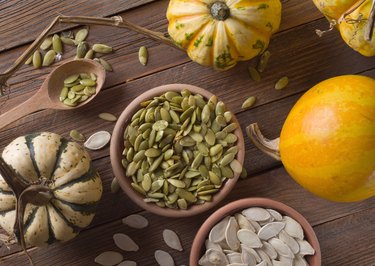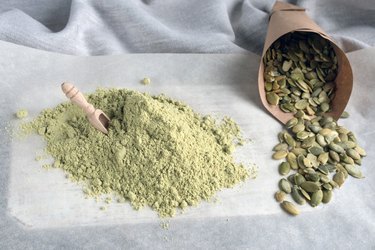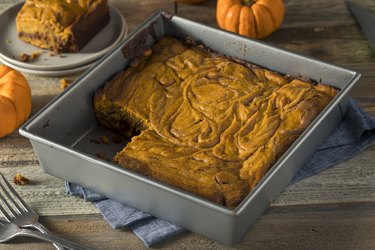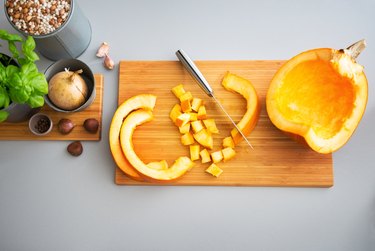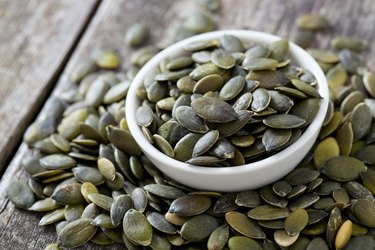
When fall rolls around, people everywhere will be enjoying the ubiquitous taste of pumpkin in everything including lattes and lip balm. But did you know eating pumpkin seed shells can be just as tasty as any other fall treat? Better still, they're surprisingly nutritious.
Curious about the health benefits of pumpkin seeds? Read on to discover the variety of culinary uses and health perks of eating the seeds whole or shelled.
Video of the Day
Video of the Day
Can You Eat Pumpkin Seed Shells?
The inside of pumpkin seeds is what most people go for, but you can save yourself some time having to remove the shell by eating the whole seed — shell and all. Eating the pumpkin seed shells means you'll get more of a crunch and more fiber per serving.
"Yes, you can eat pumpkin seed shells," says registered dietitian nutritionist Amy Gorin, RDN. "Some people may not like how crunchy the shells are, but they are edible and safe for most people to eat in moderate quantities."
"They are the perfect addition to parfaits, granola, cookies, breads and other baked goods, as salad toppers for an added crunch, or as beautiful and tasty garnishes for soups," adds registered dietitian Kelli Davenport, RD, of Top Nutrition Coaching. "Pumpkin seeds are also great for making homemade pesto or crushed and used for crusts on meat or fish."
Shelled vs. Whole Pumpkin Seed Nutrition
Both cooked and raw pumpkin are high in fiber. But the seeds also carry this heart-healthy nutrient. Pumpkin seeds are just as good for you as they are for your taste buds because they deliver protein, fiber, healthy fats and minerals.
Take a look at pumpkin seeds' nutrition below. The nutrition facts for pumpkin seeds can vary depending on whether you eat the kernel alone or the shell, too. The same serving of pumpkin seeds with the shells contains fewer calories, fat and protein but more carbs, fiber and zinc.
Per 1 ounce | Pumpkin Seeds With Shells | Pumpkin Seed Kernels |
|---|---|---|
Calories | 127 | 163 |
Total Fat | 5.5 g | 13.9 g |
Saturated Fat | 1 g | 2.4 g |
Total Carbs | 15.3 g | 4.2 g |
Fiber | 5.2 g | 1.8 g |
Sugar | 0 g | 0.4 g |
Sodium | 5.1 mg | 5.1 mg |
Protein | 5.3 g | 8.5 g |
Manganese | 6% Daily Value (DV) | 55% DV |
Magnesium | 18% DV | 37% DV |
Zinc | 27% DV | 20% DV |
Niacin (Vitamin B3) | 1% DV | 8% DV |
Benefits of Whole Pumpkin Seeds
Fiber
Pumpkin seed shells are a source of healthy nutrients, including fiber.
"When you eat a pumpkin seed with its shell, you're taking in more fiber than by eating the shelled seed," Gorin says. "Fiber is beneficial for helping cholesterol levels and with satiety, which benefits weight management. Whole pumpkin seeds contain more than double the fiber content of shelled pumpkin seeds."
Minerals and Other Nutrients
Pumpkin seeds are an especially rich source of magnesium. A quarter-cup serving offers 42 percent of your Daily Value (DV) for magnesium, a mineral many of us aren't getting enough of, according to the American Heart Association. Magnesium plays an important role in heart and bone health and can help lower blood pressure.
Pumpkin seeds also contain zinc, which fights inflammation and supports the immune system. They also have tryptophan, which can promote healthy sleep, per the Cleveland Clinic.
Risks of Eating Whole Pumpkin Seeds
Even with all these benefits, eating pumpkin seeds whole can have side effects.
In general, eating pumpkin seed shells can't hurt you, but there are some caveats. Some people are allergic to pumpkin seeds, for example.
Others may not handle extra fiber well, Gorin says. "The main risk of eating too many pumpkin seed shells is that you could take in a large amount of fiber. People with medical conditions that make it difficult to eat large amounts of fiber in a sitting, such as people with irritable bowel syndrome or Crohn's disease, may want to avoid eating in-shell pumpkin seeds or limit the amount that they consume."
Eating too many high-fiber foods, such as whole pumpkin seeds, can cause digestive upset like bloating, gas and diarrhea. Transition to a higher-fiber diet slowly, and be sure to drink plenty of water along the way.
And if they've gone bad, pumpkin seeds can cause food poisoning, leading to symptoms like diarrhea and vomiting.
Tip
Boiling pumpkin seeds in water over low-to-medium heat for about 10 minutes may make them easier to digest.
How to Prep Pumpkin Seeds
Also called pepitas, pumpkin seeds can be bought from the grocery store or made at home. Preparing your own roasted pumpkin seeds allows you to control how much salt you add compared to prepared packaged varieties.
So, how do you take the white seeds you scoop from the guts of a pumpkin and turn them into an edible snack?
1. Remove the Pulp
To improve the texture of fresh pumpkin seeds, it's important to remove all the pulp before roasting them. The pulp won't hurt you, but it might affect the way the seeds taste.
Soak the pumpkin seeds in water for a little while to get all the pulp off, then strain them before adding seasoning and spice.
2. Add Spices and Roast
Once you've cleaned your fresh pumpkin seeds, you can get creative in the way you prepare them. You can play around with sweet and savory spices.
If you want something reminiscent of pumpkin pie, you can use cinnamon, nutmeg, cloves, ginger and brown sugar. You could create another sweet treat by using cocoa powder, cinnamon and raw sugar to make them taste like hot cocoa.
If you want something savory, try garlic powder, Parmesan cheese and oregano.
After you've added your spices and other seasonings, spread the seeds out on a baking sheet and roast them at 350 degrees Fahrenheit for about 15 to 20 minutes.
Tip
Pumpkin seeds also taste great on their own without any dressing up. Roast the seeds dry — meaning no added oil or sugar — and then add them to trail mix, toss them in a salad or sprinkle them over cereal or yogurt.
How to Shell Pumpkin Seeds
If you want to prep pumpkin seeds without the shell (also known as the hull), first remove the pulp as instructed above, then follow these steps, according to Davenport.
- Spread the seeds on a countertop or cutting board, spacing them out as evenly as possible so most of the seeds don't overlap.
- Use a rolling pin to roll over the seeds with enough force so you create small cracks in the shells. Be gentle enough to keep the seeds intact.
- Boil the cracked seeds in water for about 5 minutes, or until most of the hulls have floated to the top of the water (bigger batches will take more time).
- Remove the floating hulls with a slotted spoon, then strain the pot of seeds. (You may find some remaining hulls in the mix — just pick these out once the batch is cool enough to touch safely.)
- Let the seeds cool on a towel to absorb the water. Once they're cool, they're ready to eat, store, cook or flavor. Shelled pumpkin seeds can be eaten raw, fried or roasted.
One final note from Davenport: If you're shelling pumpkin seeds at home, save the husks. "Let them air dry overnight or in a 120-degree oven for about an hour," she says. "Then use a spice grinder or food processor to pulverize the husks to a fine powder." You can add that powder to baked goods, smoothies or sauces for extra fiber. Another bonus? You'll be cutting out food waste.
The Bottom Line
Pumpkin seed shells are safe to eat for most people and offer more fiber than eating shelled pumpkin seeds.
The shells can be a little harder to digest and therefore may trigger symptoms in people with digestive health concerns.
You can roast the whole seeds at home and enjoy in a variety of dishes or own their own as a crunchy snack.
